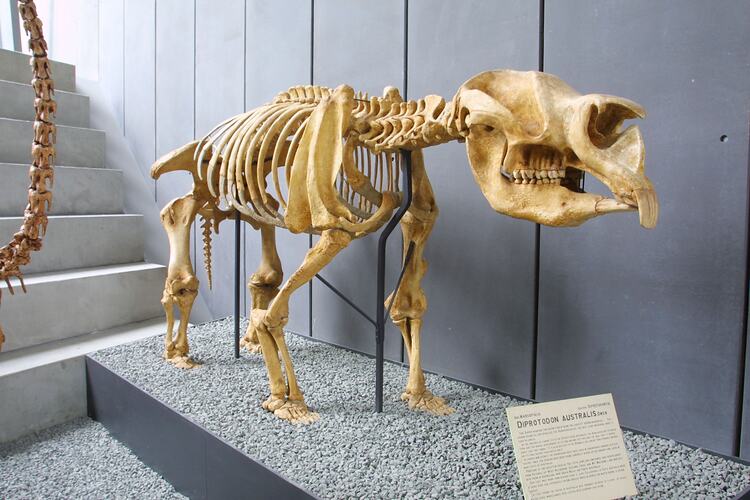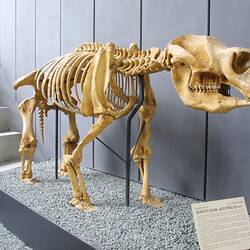This skeleton of Diprotodon is a cast of a 'composite skeleton'. This means the bones came from a number of individual animals. All of the bones were discovered at Lake Callabonna, east of the Flinders Ranges, South Australia. It was acquired for the Museum's collection in 1913.
Diprotodon was first described by Sir Richard Owen in 1838, mostly from scraps of teeth and jaw from the Wellington Caves, New South Wales. It was the first fossil mammal to be described from Australia.
Following Owen's description of Diprotodon, material was found at sites throughout Australia. Gradually Owen was able to develop an idea of what the animal's skeleton would have looked like but with one exception - the feet. So, when in 1877 Owen published his Researches on the Fossil Remains of the Extinct Mammals of Australia, he had his artist draw the skeleton of Diprotodon with its feet obscured by grass.
Unfortunately, Owen died before the mystery of the structure of Diprotodon's feet could be solved. In 1892, the year of Owen's death, a new fossil locality Lake Callabonna, east of the Flinders Ranges, South Australia was discovered.
Fossils of Diprotodon, excavated from Lake Callabonna in 1893 and described in 1899, finally revealed the elusive structure of the front and hind feet of Diprotodon and completed this prehistoric jigsaw puzzle.
References and further reading:Owen, R. (1838). Fossil remains from Wellington Valley, Australia. Marsupialia. Three expeditions into the interior of eastern Australia, with descriptions of the recently explored region of Australia felix, and of the present colony of New South Wales, 2, 359-369.
Stirling, E. C., & Zietz, A. H. C. (1899). Fossil remains of Lake Callabonna. WC Rigby.
Kadimakara: extinct vertebrates of Australia. Lilydale: Pioneer Design Studio, 1985.
Long, J. A. (2002). Prehistoric mammals of Australia and New Guinea: one hundred million years of evolution. JHU Press.
More Information
-
Keywords
-
Authors
-
Article types

